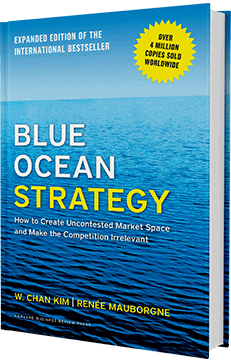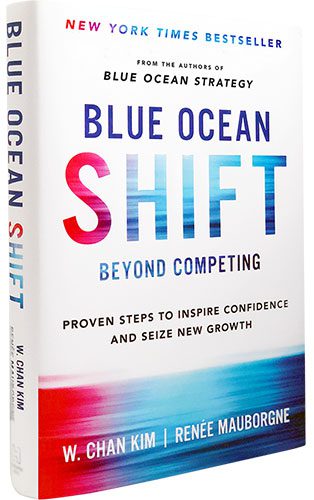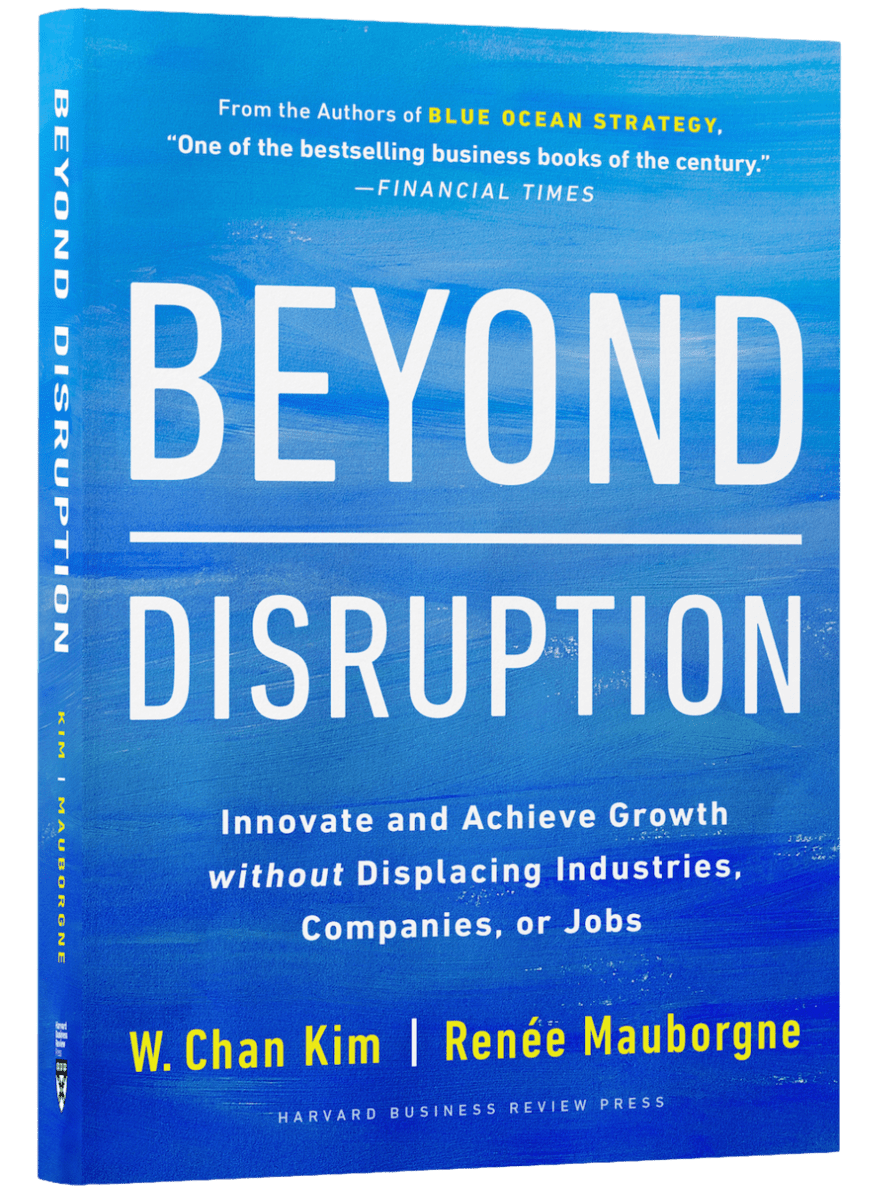WHAT IS BLUE OCEAN STRATEGY?
BLUE OCEAN STRATEGY is the simultaneous pursuit of differentiation and low cost to open up a new market space and create new demand. It is about creating and capturing uncontested market space, thereby making the competition irrelevant. It is based on the view that market boundaries and industry structure are not a given and can be reconstructed by the actions and beliefs of industry players.

WHAT ARE RED OCEANS AND BLUE OCEANS?
In their classic book, Blue Ocean Strategy, Chan Kim & Renée Mauborgne coined the terms ’red ocean’ and ‘blue ocean’ to describe the market universe.
RED OCEANS
RED OCEANS are all the industries in existence today – the known market space. In red oceans, industry boundaries are defined and accepted, and the competitive rules of the game are known.
Here, companies try to outperform their rivals to grab a greater share of existing demand. As the market space gets crowded, profits and growth are reduced. Products become commodities, leading to cutthroat or ‘bloody’ competition. Hence the term red oceans.
RED OCEANS
BLUE OCEANS
BLUE OCEANS, in contrast, denote all the industries not in existence today – the unknown market space, untainted by competition. In blue oceans, demand is created rather than fought over. There is ample opportunity for growth that is both profitable and rapid.
In blue oceans, competition is irrelevant because the rules of the game are waiting to be set. A blue ocean is an analogy to describe the wider, deeper potential to be found in unexplored market space. A blue ocean is vast, deep, and powerful in terms of profitable growth.
BLUE OCEAN STRATEGY VS RED OCEAN STRATEGY
Learn the key differences between red ocean and blue ocean strategy.
RED OCEAN STRATEGY
BLUE OCEAN STRATEGY
© Chan Kim & Renée Mauborgne. All rights reserved.

MEET THE AUTHORS
#1 Management Thinkers in the World
Chan Kim and Renée Mauborgne
are the authors of the New York Times Best Seller Blue Ocean Shift and the 4 million copy global bestseller Blue Ocean Strategy. In 2023, they were chosen as two of the four leading thinkers in the 100 years of Harvard Business Review’s publication. In 2019, they were named the #1 Management Thinkers in the World by Thinkers50.
KEY POINTS OF BLUE OCEAN STRATEGY & SHIFT
The fundamentals that will jump-start your strategy development process.
It’s grounded in data
Blue ocean strategy is based on a decade-long study of more than 150 strategic moves spanning more than 30 industries over 100 years.
It creates uncontested market space
Blue ocean strategy doesn’t aim to out-perform the competition. It aims to make the competition irrelevant by reconstructing industry boundaries.
It empowers you through tools and frameworks
Blue ocean strategy offers systematic tools and frameworks to shift from red ocean of competition to blue oceans of new market space.
It shows you how to create a win-win outcome
As an integrated approach, blue ocean strategy shows how to align the three strategy propositions – value, profit, and people – to create a win-win outcome. Blue ocean shift builds humanness into the process to build people’s confidence to own and drive the process.
BLUE OCEAN STRATEGY TOOLS AND FRAMEWORKS
Put these practical market-creating tools into practice.
Learn how to put these practical market-creating tools into practice to move from red ocean of competition to blue oceans of new market space and to do so in a way that people own and drive the process.
READ THE BOOKS
The books that changed the way we think about strategy.
Blue Ocean Strategy
The origin of the terms red and blue oceans comes from Blue Ocean Strategy – How to Create Uncontested Market Space and Make the Competition Irrelevant.
Recognized as one of the most iconic and impactful strategy books ever written, Blue Ocean Strategy argues that cutthroat competition results in nothing but a bloody red ocean of rivals fighting over a shrinking profit pool.
It presents a systematic approach to making the competition irrelevant and outlines principles and tools any organization can use to create and capture their own blue oceans.
Blue Ocean Shift
Blue Ocean Shift is the essential follow-up to Blue Ocean Strategy. Drawing on more than a decade of new research, Blue Ocean Shift: Beyond Competing – Proven Steps to Inspire Confidence and Seize New Growth is the definitive guide to help you move beyond competing, inspire your people’s confidence, and seize new growth. Blue Ocean Shift is the New York Times and #1 Wall Street Journal bestseller.
The books have collectively sold over 4.5 million copies worldwide.
BEYOND DISRUPTION
Innovate and Achieve Growth without Displacing Industries, Companies, or Jobs
With three decades of research, the #1 global bestselling authors of Blue Ocean Strategy, W. Chan Kim and Renée Mauborgne, reveal another way to innovate and grow. Just as Blue Ocean Strategy redefined the essence of strategy as creating not competing, Beyond Disruption redefines and expands the existing view of innovation by introducing a new approach, nondisruptive creation, that is free from the destructive displacement that happens when innovators set out to disrupt.
“Nondisruptive creation is a pathbreaking new concept that shows leaders and innovators how business can be a force for good. This book will become a business classic.”
—Jake Cohen, Senior Associate Dean at the MIT Sloan School of Management

BLUE OCEAN SPRINT with AI NAVIGATOR
Kickstart Your Growth, Break Free from Competition, and Redefine Your Market to Seize New Opportunities
Leverage the new AI Navigator, your superpowered Blue Ocean-trained partner in strategy and put it to work for your business.
“LOVED this course. No nonsense, 100% practical tools I can start implementing TODAY in my organisation!” Amalia C., Google
BLUE OCEAN EXAMPLES
Why are some companies able to create ‘blue oceans’ of uncontested market space while others struggle in ‘red oceans’ of intense competition?
To answer this question, we need to look at some examples from a range of industries and identify the specific strategic actions blue ocean companies took to achieve profitable growth.



